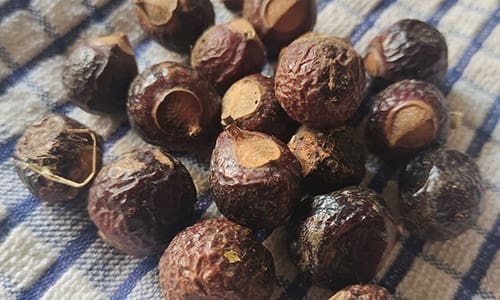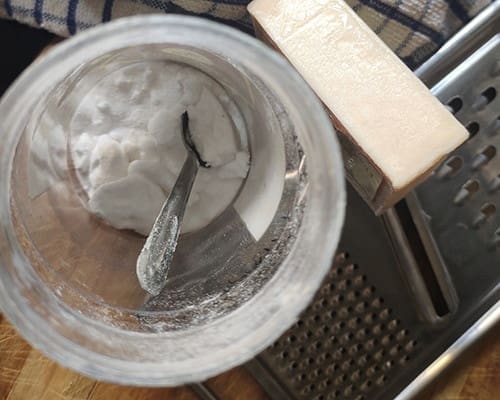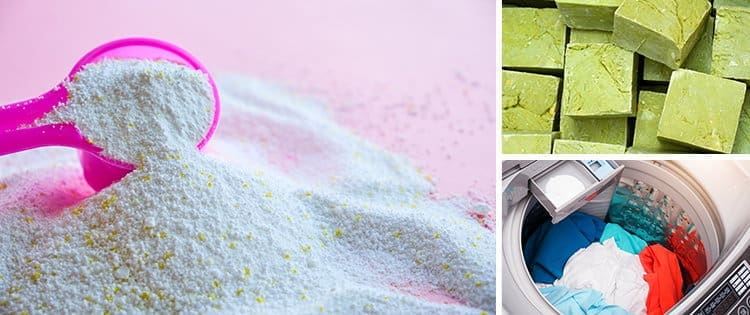There are multiple reasons why we move away from industrial, mass-produced products to find alternatives that are made using simpler, natural ingredients and processes.
One major factor is environmental concerns and sustainability. The other is the wish to live healthier, controlling the exposure to harmful chemicals that seep their way into our lives and bodies.
The first steps towards this are usually the more obvious – eating natural foods, reducing plastic packaging, segregating waste, and choosing natural personal care routines. As we scrutinize our lives further, we realize that it is the mundane, everyday habits that need to be tweaked as well. As tiring and cumbersome that it is, laundry remains a big part of our lives, making it a big factor in our journey towards sustainable and non-toxic living.
The seemingly harmless spoon of detergent that we put into our machine with every wash cycle, has a big impact on the environment, on our health and on the health of children, animals, and other participants in our ecosystem.
Commercial detergents typically have sulphates and phosphates, which are released into the wastewater after every machine wash, entering the drainage system – eventually polluting our water bodies and disturbing the local ecosystem.
Additionally, the chemicals in the detergents are toxic to the body, causing reactions ranging to rashes and allergies, and even being carcinogenic. Additionally, harsh detergents are not always friendly towards the fabric, and can cause quick degradation and release of microfibers into the water.
Families with children and pets would do better to stay away from commercial detergents and need to worry that products such as these are kept far out of reach.
Considering the heavy presence that laundry has in our lives, these are compelling reasons to choose alternative methods. With organic or nontoxic detergents in the market being an expensive affair, it is a cheaper and long-term sustainable alternative to try to make it ourselves.
Here are a few solutions to find your own laundry detergent, either using easily available cleaning alternatives, or following a recipe to make your own.

Vinegar
A simple alternative to store bought detergent is white vinegar. It is effective in removing stains, brightening fabric, and is also effective as a fabric softener.
Vinegar helps fix darker colors and can get rid of stronger odors like smoke. It works well for washing machines and can even be used only for the rinse cycle in combination with other cleaning options. Vinegar can also be used to clean your washing machines.
Be sure to use white vinegar, to prevent any soiling of your fabric.

Salt
Believe it or not, salt is incredibly hand and powerful when it comes to managing laundry.
It helps fasten colors of darker clothes and is very effective when it comes to removing stains. Salt can be used for hand washing clothes as well as in machine cycles. However, it may not be a great idea using salt in areas with hard water.
Salt can also be used in combination with vinegar.
Soap Nuts
The fruit of the soap nut tree, when dried and combined with water is effective with cleaning and even has a lather.
If you can get your hands on a pile of soap nuts, be sure to save them in a dark and dry corner. All you need is a handful, tied together in a little cloth pouch, and put this in with your clothes during the wash cycle. Be sure that you tied the cloth pouch securely, so that the soap nuts do not spill out.
You could consider smashing the soap nuts or grinding them into a coarse powder to get a more effective wash.
Related: If You Have This Plant in Your Backyard, You Will Never Run Out of Soap

Borax and Washing Soda Recipe for a DIY Detergent
This is a simple recipe, that helps you make your own detergent that is as easy to use and as effective as a store-bought option. You can make this in larger batches and store them in dry, airtight containers away from the sun.
What you need:
• 1 bar of natural soap
• Borax powder
• Washing soda or sodium bicarbonate
• Essential oil (e.g., tea tree or lemon grass)

Method:
Use a food processor or a grater and grate the soap bar into fine flakes. A fine grate will help the soap dissolve quickly during a wash cycle without leaving sticky sediments on your clothes or the machine.
Get a dry mason or glass jar and using it to mix the ingredients. The same jar could also be used to store the ingredients afterwards.
Mix 2 parts of washing soda, 2 parts of borax and 1 part of soap. The best way to do this is to fill the mason jar partly (leave about half the jar empty) and seal it tight. Shake the jar about for a couple of minutes until the ingredients are well mixed.
If you wish to use essential oils, you could put in a few drops at the time of mixing the ingredients. They lend a fragrant odor and have properties such as prevention of mildew (tea tree) or keeping insects away (lemongrass).
Related: DIY Cheap & Portable Washing Machine

Using your DIY detergent:
Use the detergent just as you would use a commercial detergent during your wash cycle. A regular full load will used about 3 tablespoons of detergent. Efficient washing machines, and clothing that are minimally used can use less detergent (1-2 tbsp).
Laundry detergent that turns hard or cakes up would be better discarded or used for hand washing. This happens when the detergent may be exposed to moisture, and this may leave a sticky residue on clothes when used in a washing machine.
Selecting a natural soap with a pleasing fragrance is an easy way to prevent the use of additional essential oils. Naturals soaps are often made with essentials oils, so this is a simple way to reduce one step of your process – and saves you on the shopping as well!
You can increase the cleaning power of the detergent by increasing the amount of borax in your mix, however high concentration of borax can cause uneasiness in children and pets, so it is best to stick to the recipe.
Borax is also not advised for sensitive skin. Baking soda may be used as a substitute for borax. You may also experiment with adding a little salt to your recipe.
With these tips to better laundry, it is not such a hard task to keep toxic chemicals away from your wash cycle, with surprisingly few and easy to source ingredients. That’s one step closer to a cleaner and greener lifestyle!
You may also like:
 DIY Cheap Bio Enzyme Solution For Home Cleaning
DIY Cheap Bio Enzyme Solution For Home Cleaning
Similar to Morphine: The Best Natural Painkiller that Grows in Your Backyard (Video)
If You Have Pets, Get Rid Of These Plants Immediately!
How You Can Find Out If Your Homestead Water Is Polluted Or Clean









My first diy laundry soap included grating bars of soap, my 2nd method of making diy laundry soap was boiling the ingredients on the stove & then pouring into bottles…both very messy.
Here is what I do (easy & successful) =parts baking soda, washing soda, borax, & oxyclean. Also powdered Biz (enzyme laundry formula, hard to get, walmart sometimes carries it, but I’m searching for substitute). For extra cleaning, soak laundry before running machine. Mix all together & use a small scoop in washer.
For pre wash & all purpose spray cleaner around house. = parts alcohol, hydrogen peroxide & squirt of Dawn. Pre spray & soak with laundry in washer. Rub stain gently with finger first. As all purpose cleaning spray, use your usual cloths or rags. For grease, sticky stuff, fingermarks etc, pair with magic eraser. Cleans appliances, kitchen fans, sinks, faucets etc. Effective but gentle.
Ive been using Borax, Washing Soda and Oxyclean for several years and it does a great job on my clothes with no detergent after oder.